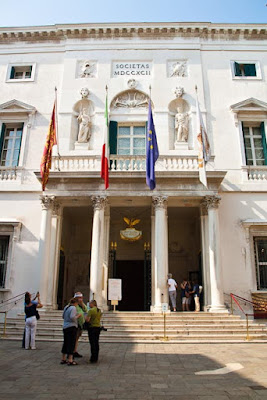On our last day with the AWAI's Photography Expedition to Venice, Itlay, we got to experience everyone's dream of what to do in Venice - glide along the canals in a gondola. There are only 425 gondoliers in the whole of Venice, as the number of licences granted is strictly controlled by their guild, and are generally passed down from father to son in a family. Even so, there are long periods of training and apprenticeship culminating in a rigorous exam, before a gondolier is deemed proficient enough to take charge of his gondola.
Two of our three gondolas, taken from the other one.
A gondoliers right of way.
Our gondolier
Gondoliers have transported passengers through the canals of Venice for nine centuries, but it wasn't until 2009, that the first female gondola was allowed to take up her oar, and break the ancient taboo against women gondoliers. Gorgia Boscolo fought long and hard for her gondolier's licence, and we were lucky enough to see her in action.
Gorgia Boscolo rowing a tragghetto across the Grand Canal
After our gondola ride, a group of us walked to find Teatro La Fenice, newly built after the devastating fire in 1996.
La Fenice Theatre
As we walked up the steps of the theatre, we were surprised to see the Director of the Theatre, and his leading man in the opera Don Giovanni, going over the score.
Venice was expecting the Acqua Alta (High water) that
blights the city. These platforms were ready to be put out for
people to walk on when the floods come.
We returned to our hotel just in time, as we would have been unable to reach it only moments later. A demonstration was forming outside the nearby railway station and the roads were being blocked off by riot police.
Riot police blocking our way
We later discovered that the demonstrators were immigrants demanding the same rights as Italian citizens. Later, one of our number, Peggy, had a conversation with one of the demonstrators. She was a Nigerian, who was working illegally in Venice on a three-month tourist visa. Each time her visa ran out, she returned to Nigeria, only to return on a new tourist visa. So much for hard-done-by immigrants!
Later, we managed to circumvent the barriers and make our way to Al Giardinetto da Severino, where we had our final dinner together. This was such a great workshop, I was so sorry that it had come to an end!






































